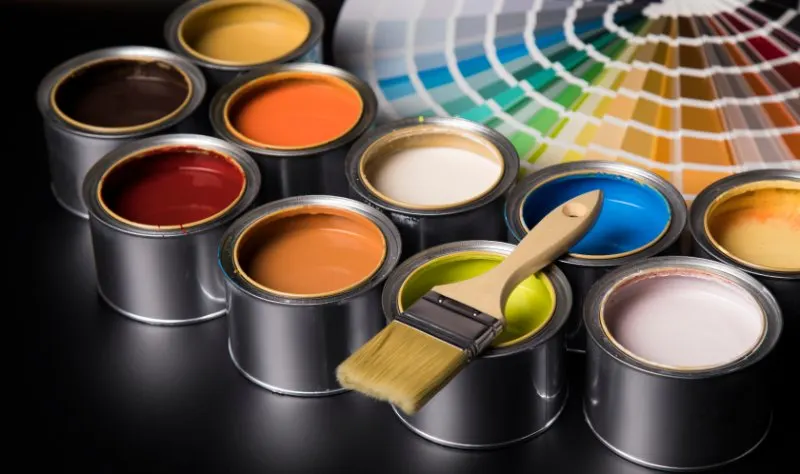Acrylic paint is commonly used by artists and children for either professional or school arts. Many of these art materials claim to be non-toxic and safe for children’s use. But do we know what are the main contents of this kind of paint? Are they really safe and environmentally friendly? Is acrylic paint bad for the environment?
What are the common paints?

- Acrylic paint which is water-soluble and made of polymerized acrylic resin is the most popular in the world.
- Watercolor which is water-soluble and made of liquid pigments dissolved in water.
- Oil paint which is oil soluble and made of liquid pigments dissolved in the medium commonly is oil.
- Liquitex ink which is dye-based and made of pigment, binder, and solvent.
See Related: Is Hair Dye Bad for the Environment?
What is paint made of?
Paints are made of pigments, binders, and solvents. The key component is the pigment which determines whether the paint is water or solvent-based.
Pigments can be made of mineral, plant, or animal material. Although the ingredients in paints are not harmful to the human body long-term exposure to some substances might cause certain diseases.
These pigments are also commonly used in the food and cosmetic industry. There are some toxic pigments like cadmium sulfide, mercury chromate, cobalt chloride, or lead chromate. Pigments are responsible for giving color to the paint.
These pigments are then suspended by an acrylic polymer emulsion and plasticizers (synthetic resin binder) to make it stick or dry on any surface. Binders are usually synthetic resins or natural polymers such as acrylic polymer emulsion. Many of them are known harmful to health, especially in the air, water, and soil.
Solvents are the substances that make pigment and binder dissolve in water or oil. They are generally toxic organic chemicals.
Additives are commonly added substances added in some paints to alter some properties of the paint. For example, thickeners are added to oil paints while retardants or extenders are added to watercolors to slow down the drying process.
And in acrylic paint, there are commonly added acrylic mediums.
See Related: Best Greenhouse Paint & Spray-On Shading
Acrylic polymer emulsion
Acrylic polymer emulsion serves as the binder in most acrylic paints, they are mostly made of compounds like methyl methacrylate and a common catalyst mostly made of carbon and hydrogen.
Although humans can not ingest this chemical compound it can affect the skin and may cause cancers.
See Related: Best Conservation Books to Read
What are acrylic paints, what are they commonly made of?

Acrylic paints are ‘plastic’ or called latex paint which means they contain plasticizers which are basically liquid plastic to make them stick or dry on any surface. They produce toxic chemicals such as formaldehyde, acetal, acrolein, and ethylene oxide when exposed to intense heat.
Some acrylic paint contains cadmium, cobalt, manganese, chromium, and lead. These metals and substances can cause damage to the brain and kidneys and can also cause nervous system disorders.
Acrylic paint also contains carcinogenic pollutants such as benzene, xylene, styrene, and butadiene. Benzene is an ingredient used in pesticides; it has been shown to cause leukemia, non-Hodgkin’s lymphoma, and other blood disorders.
See Related: Most Ethical Gemstones: Is Mining Ethically Possible?
What are watercolors, what are they made of?
Watercolors are liquid paint that contains pigments, water, and a binder. It is very easy to clean out of clothing or skin than acrylic paints.
Watercolors contain harmful volatile organic compounds such as acetone, benzene, and toluene. These are suspected to be carcinogens with long-term exposure. They can cause damage to the central nervous system and can cause reproductive disorders.
See Related: Most Eco-Friendly Cars for Any Lifestyle
What are oil paints, what are they made of?

Oil paint is made of pigments, binders ( commonly linseed oil ), and solvents like turpentine. Solvents used in creating oil paint are very toxic; they can be harmful to our respiratory system if inhaled or absorbed through the skin.
They also contain poisonous substances such as bone oil which is made of animal materials, the mineral spirit which is made of petroleum, and white spirit.
Oil paints can cause problems to the eyes if not handled properly; it contains agents like cyclopentanone that are corrosive to the eye. The combustion Gases ( CO ) produced when burning oil paint may be also harmful to living things.
However, oil paint is very safe to use if it is not exposed to extreme heat. If heated with high temperatures, they produce dangerous gases which can cause cancer in the lungs and throat.
See Related: Are Bath and Body Works Candles Toxic?
What are the common health hazards in using acrylic paint
- Acute or chronic dermatitis, canker sores around the mouth, lips, nose also. Pigment particles are the most common cause of skin irritation causing allergic reactions. Acrylic painters are very prone to these skin reactions due to direct contact.
- Acute or chronic bronchitis is characterized by inflammation of the lining tissues of the lungs. It is hard to diagnose therefore it needs to be properly diagnosed.
- Cancer of the lungs, throat, and tongue.
- Ear, nose, and throat problems characterized by nasal stuffiness, runny nose, sore throat.
- Rashes on the skin are also common however it can be avoided by wearing protective clothing while painting indoors to avoid contact with the vapors released from acrylic paints. What are the common health hazards in using watercolors:
- Eye irritation is characterized by redness, watering, blurry vision.
- Paralysis of facial muscles or even breathing problems. These are most likely to occur when a child is accidentally exposed to them and not properly taken care of.
See Related: Best Clothing Companies That Plant Trees
Is acrylic paint biodegradable?

For most products, the answer is no. They can cause harm to living things and pollute our environment when not disposed of properly.
However, some companies are making biodegradable acrylic paints and other environmentally friendly art supplies, that would be safer to use by adding natural ingredients that will help in breaking down the paint into harmless components that would not cause damage to the environment.
For companies that manufacture these kinds of paints, it would require testing and approval from the government to ensure that they are safe to use.
See Related: Are Biodegradable Balloons Bad for the Environment?
How does acrylic paint affect the environment?
Acrylic paint is very hard to clean up when it spills. It is difficult to remove from walls, fabrics, and floors when it spills or leaks from containers. It contains pigments that are not biodegradable therefore, they remain in the environment for a long time, making them bio-accumulative.
Pouring acrylic wastewater into sewages and drains during disposal can go to water bodies and harm aquatic life. The heavy metals of acrylic paint can cause health problems to aquatic life and the environment.
Alcohol and ammonia in acrylic paint can be harmful to one’s health. Benzene in acrylic paint can harm the environment by polluting the atmosphere. Benzene is also toxic to animals.
See Related: Best States for Sustainable Living
How do you know whether the paint is safe or not?

In general, if the paint does not have pigments it can be considered as non-toxic paint. Also if the paint has no heavy metals or cancerous chemicals in its ingredients then it is considered to be safe for use.
If you are not sure of the contents of paint, it may be better to avoid them and look for other alternatives that do not contain any chemicals. Many paints can dry or release carcinogenic gases when exposed to heat or sunlight. It is recommended to keep the paint away from direct sunlight when it is not in use.
The best way to use paint in the safest way is using non-toxic versions. Always look for environmentally friendly art supplies.
See Related: Best Compostable Trash Bags
Conclusion

The common contents used in acrylic paint are not environmentally friendly. They include heavy metals like, toluene, xylene, styrene monomer, and benzene-based solvent all of which can be hazardous waste and go to water streams and affect aquatic environments.
Furthermore, when the acrylic paint thinner evaporates it leaves behind excess formaldehyde additives released in the air during the drying process these methanal vapors can cause respiratory problems.
Artists need to use care when disposing of their acrylic paint or latex paint residues. They should take due diligence in removing any residual solvents that could lead to environmental and human health hazards.
In conclusion, it is not wrong to use acrylic paint when needed, but we can lessen the usage of this paint by choosing natural paints and other environmentally friendly art supplies.
Is acrylic paint made out of plastic?
Acrylic paint is not made out of plastic. It’s a water-based paint that uses acrylic polymer emulsion as a binder. Acrylic polymer emulsion is a synthetic resin that is made from a combination of acrylic monomers. This binder is what gives acrylic paint its adhesive quality and allows it to adhere to a variety of surfaces.
What is acrylic paint made from?
Acrylic paint is a type of water-based paint that is made from a mixture of acrylic polymer emulsion and pigment. The polymer emulsion acts as a binding agent that holds the pigment together and allows it to adhere to surfaces such as canvas or paper. Acrylic paint is known for its fast drying time, versatility, and ability to create a range of textures and effects.
Does acrylic paint dry like plastic?
Acrylic paint is a water-based paint that dries quickly and forms a plastic-like film on the surface it is applied to. Unlike oil-based paints, acrylic paint dries to a durable, flexible finish that is resistant to cracking and flaking. This makes it a popular choice for artists and DIY enthusiasts who want a long-lasting, high-quality finish on their projects.
Related Resources
